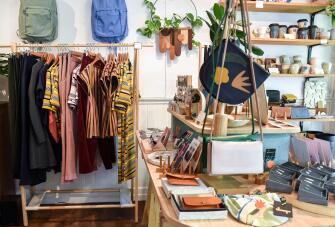Boost Retail Sales with Consumer Durables Strategies
What do a sofa, a blender, and a bike have in common? Nope, this is not the start of a very weird joke. They’re all consumer durables, things made to last.
The great thing about these products is that they stick around for a long time (shocking, given the name "durable," right?). That means less waste, more sustainability points, happy customers who don’t have to replace things every five minutes.
Sell these types of consumer goods online, and you’ll attract people who actually care about quality. Keep those customers close, and you’re looking at serious loyalty and better profit margins.
In this guide, we’ll look into how consumer durables are made, how they stack up against other products, why it might be a good idea to be a part of the consumer durables industry and how to sell these types of consumer products.
Understanding consumer durables
Consumer durables (aka durable goods) are the stuff you buy once and keep for years, not days. They don’t get used up like a bottle of shampoo, and they’re usually a bit of an investment.
Let's look a little closer and answer: what are consumer durables?
Definition and key characteristics
Here’s what they all have in common:
- They last at least three years (sometimes their shelf life is way longer).
- They don’t run out when you use them.
- You don’t buy them every other week, they don't have to be purchased frequently.
Think of them as the long-term relationships of the shopping world.
Consumer durables vs. nondurable goods
The difference is pretty simple. Consumer durables are built to last, but nondurable goods aren’t.
If a product sticks around for years, it’s durable. If it’s gone after one use (or a few weeks), it’s nondurable. Think fridge vs. milk.
|
Feature |
Consumer Durables |
Nondurable Goods / Consumer non-durables |
|
Lifespan |
3+ years |
Less than 3 years |
|
Usage |
Not used up |
Immediately consumed or consumed quickly |
|
Purchase frequency |
Infrequent. tThey last for long periods |
Frequent |
|
Price |
This product category is usually more expensive |
Bread, shampoo, batteries |
The role of durability and price in buying decisions
When something costs more and lasts longer, people buy it less often, it’s that simple. Durability means fewer replacements, and a higher price tag makes shoppers think twice before hitting that buy now button.
Examples of consumer durable goods
Durable goods come in two main forms. soft and hard. Soft goods are the bendy, comfy stuff like bedding and towels.
Hard goods are the tough, solid items like appliances and electronics.
Here are examples of consumer durables:
Household goods and home appliances
- Washing machines
- Refrigerators
- Air conditioners
- Ovens
- Microwaves
- Vacuum cleaners
- Ceiling fans
Furniture and office furnishings
- Desks
- Chairs
- Cabinetry
- Sofas
- Beds
- Dining tables
- Bookshelves
- Filing cabinets
- Wardrobes
Electronics and consumer tech
- TVs
- Laptops
- Smartphones
- Gaming consoles.
Vehicles, sporting goods, and other high-value items
- Bicycles
- Treadmills
- Cars
- Fine art
- Luxury jewellery
- Designer watches
These are just a few consumer durables examples. There are thousands more you could sell. If it’s built to last and not something you throw out after a few uses, it probably counts.
Why consumer durables matter in retail
Durable goods are a great way for people working in or looking into the consumer durables field to gauge how the economy’s feeling. When sales are up, it usually means people are confident about spending.
Here's more on that:
Economic significance and market trends
Durable goods sales are like retail’s pulse check. Strong numbers often point to a healthy economy and positive market trends. That’s why they’re such a big deal for analysts doing market research and retailers alike.
The US Bureau of Economic Analysis shows this in action. Over the past 70 years, personal spending on durable goods has steadily grown. In just the first quarter of this year, Americans spent more than $2.2 trillion on durable goods alone.
Indicators of consumer confidence
Economists track durable goods orders the way sports fans track scores. It tells them who’s winning (and who’s not) in the economy. If orders are climbing, people are generally feeling optimistic.
Long-term value for retail businesses
These products often come with higher average order values. Even though customers buy them less often because they last a relatively long time, there’s huge potential for repeat sales through add-ons.
Strategies to increase sales of consumer durables
You know what consumer durables are and why they’re awesome for business, now let’s talk about how to actually sell more of them.
Educating customers with in-store and online marketing
When you're selling consumer durables, you have to show your customers why they're worth the investment. As mentioned earlier, these products usually come with a higher price tag and that’s totally fine. After all, no one expects to pay the same for a fridge or a bike as they do for a bottle of shampoo.
However, you still need to show them the value in your products. Unlike cheap, everyday items, durable goods are a bigger investment and customers take more time thinking about whether they should purchase or not. If they don’t understand why the product is worth it (how it lasts longer, performs better, or saves money over time), they might walk away or buy a cheaper alternative.
Educating them on the value removes doubt, builds trust, and increases the chance they’ll actually buy. Essentially, it turns a pricey product from a maybe into a yes; this makes sense.
Here's how to do that:
Online tips
- Use blogs, videos, and social media to share your product's USPs.
- Compare your durable products with cheaper alternatives.
- Share tutorials, maintenance tips, and real-life customer stories to build trust.
In-store tips
- Set up demo stations so customers can see and touch the products.
- Use signage or interactive displays to explain features and longevity.
- Train staff to confidently answer why your products are worth the investment.
- Check out our in-store retail marketing guide for more tips on boosting engagement and sales.
Leveraging flexible payment options for big-ticket items
Let’s be honest. Not everyone has a spare few hundred (or sometimes thousand) dollars lying around. That’s where flexible payment processing options come in. Offering buy now, pay later (BNPL) or financing plans makes those big purchases way easier to swallow.
Splitting the cost into smaller, manageable chunks takes the stress off your customers’ wallets. Suddenly, that fridge, bike, or laptop doesn’t feel so scary.
It's clear this method is really popular. According to Motley Fool, 40% of Gen Z used BNPL at least once since it became available, and 48% of millennials did the same.
So, as a retail business owner, be sure to integrate your online store with popular platforms like Klarna and Afterpay.
Building trust through quality and warranty programs
When people are spending more on a durable product, they want reassurance.
Warranties, guarantees, and returns make them feel safer about their purchase. It’s essentially telling your customers that, although this product is built to last, if something goes wrong, we’ll still fix it.
Even a simple one-year warranty can make a big difference. It shows confidence in your product and reduces the fear of spending a lot upfront.
Easy returns are just as important. No one wants a complicated process if something doesn’t work out.
Cross-selling and upselling durable product accessories
Bought a bike? Don’t stop at the pedals. Helmet, lock, fancy water bottle, why not? Snagged a laptop? Case, mouse, extra storage… you get the idea. Accessories make the main purchase even better.
Cross-selling and retail upselling isn’t just good for your bottom line, it makes your customers’ lives easier, too. They leave fully kitted out, happy, and more likely to come back for round two.
You could also introduce loyalty programs so that when they buy more than one item they get rewarded.
Showcasing sustainability and longevity benefits
Eco-conscious shoppers love a product that lasts. Highlighting the durability of goods shows them your items aren’t just one-and-done, they stick around for years. A long-lasting fridge, a sturdy bike, or a solid sofa isn’t just smart for their wallet; it’s better for the planet too.
Share quick stats, lifespan info, or even tips on care and maintenance. It gives customers a reason to feel good about their purchase and positions your brand as one that values quality and sustainability.
The Complete Retail POS System
Delight shoppers as you speed up sales and grow your retail business. Tailor your POS system software to your exact needs with our AppStore.
Case studies and industry insights
Some of the biggest names in consumer durables show just how much staying power matters:
Successful retail campaigns for durable goods
- Apple: Famous for consumer electronics that last, Apple sticks to a “Longevity, by Design” approach. One iPhone or MacBook can serve you for years, making the higher price totally worth it.
- BMW: This German car maker sells high-spec vehicles built to last. A BMW isn’t an impulse buy—it’s a serious investment that outlives most nondurables.
- Ikea: Even when playing the affordability game, Ikea makes furniture that’s built to last. Energy efficiency and practicality keep it a go-to for durable home goods.
- SharkNinja: From air fryers to blenders, SharkNinja has made a name with kitchen gadgets that last. Their Q2 2025 numbers show a 52.8% jump in food-prep appliance sales, proof that durable, innovative products sell.
These companies prove that durability, quality, and smart design can turn a big-ticket item into a lasting customer favorite.
Turning durable goods into lasting revenue
So there you have it. Our complete guide on the consumer durables sector packed with tons of tips to help you get the most out of selling durable goods.
With consumers enjoying more disposable income, now’s the perfect time to make big-ticket items fly off the shelves.
The key is doing this well is knowing what’s selling, when, and to whom. That’s where having a retail POS system can help. It'll give you real-time insights into your durable goods sales, track trends, and help you optimise inventory. That means you can spot your top sellers, manage stock smarter, and keep customers coming back for more, all while making your business more profitable.
Ready to turn durable goods into lasting revenue? With Epos Now, you’re set up for smarter sales, happier customers, and a healthier bottom line.
Learn something new today? Check out our other educational resources. Some great options to follow this include our retail problems and solutions blog and our KPIs in retail blog.
FAQs
- What qualifies as a consumer durable good?
-
Products built to last, like appliances, electronics, furniture, and vehicles.
- How do consumer durables differ from nondurable goods?
-
Durables last years, nondurables are used up quickly, like food or toiletries.
- Why are consumer durables important to retail sales?
-
They drive higher revenue, repeat purchases, and reflect consumer confidence.
- What marketing strategies work best for consumer durables?
-
Educating customers, flexible payments, cross-selling accessories, and highlighting durability.




